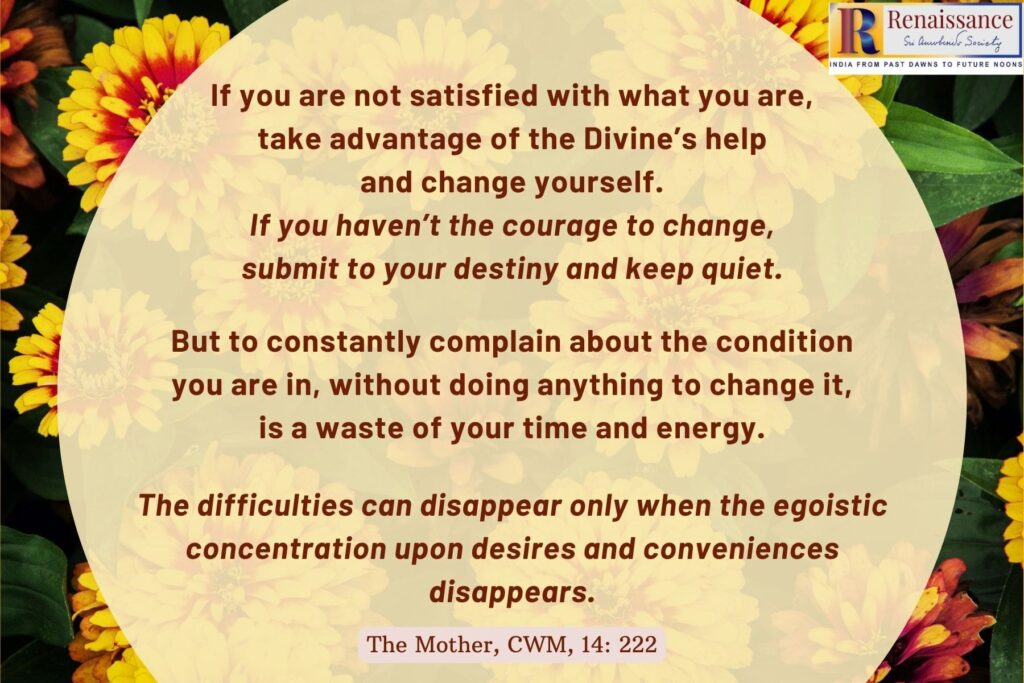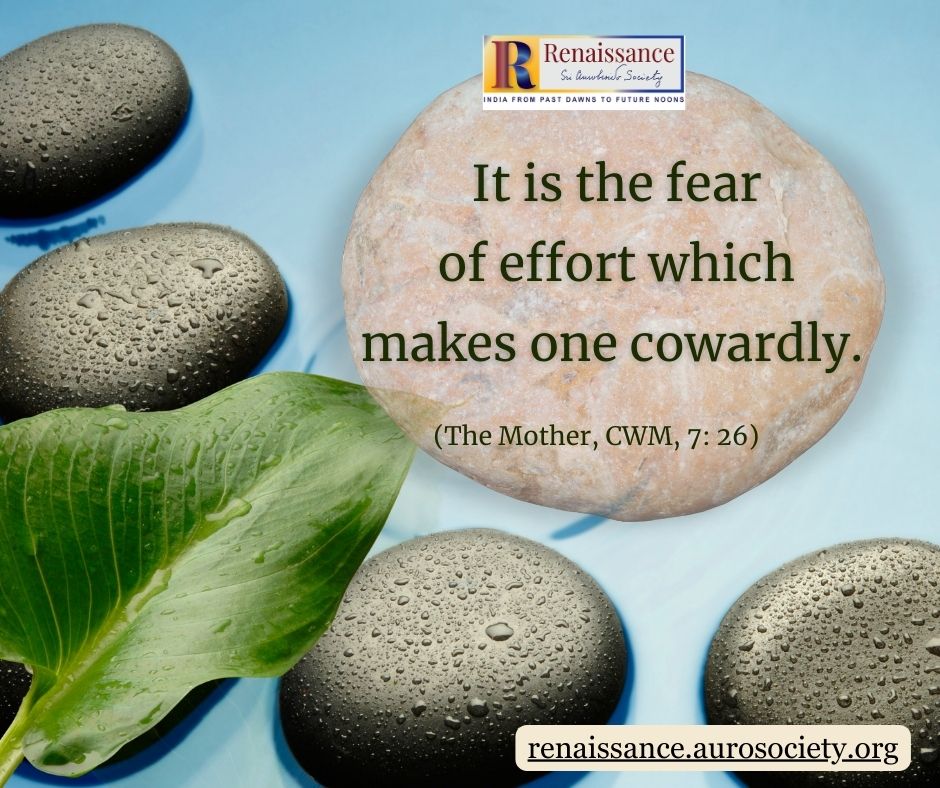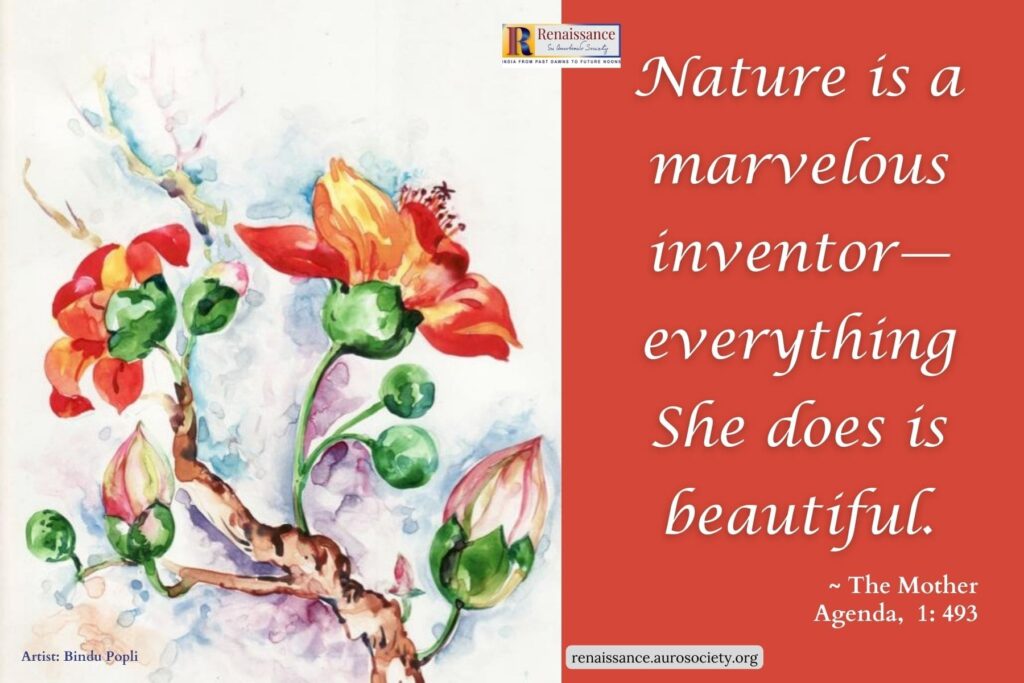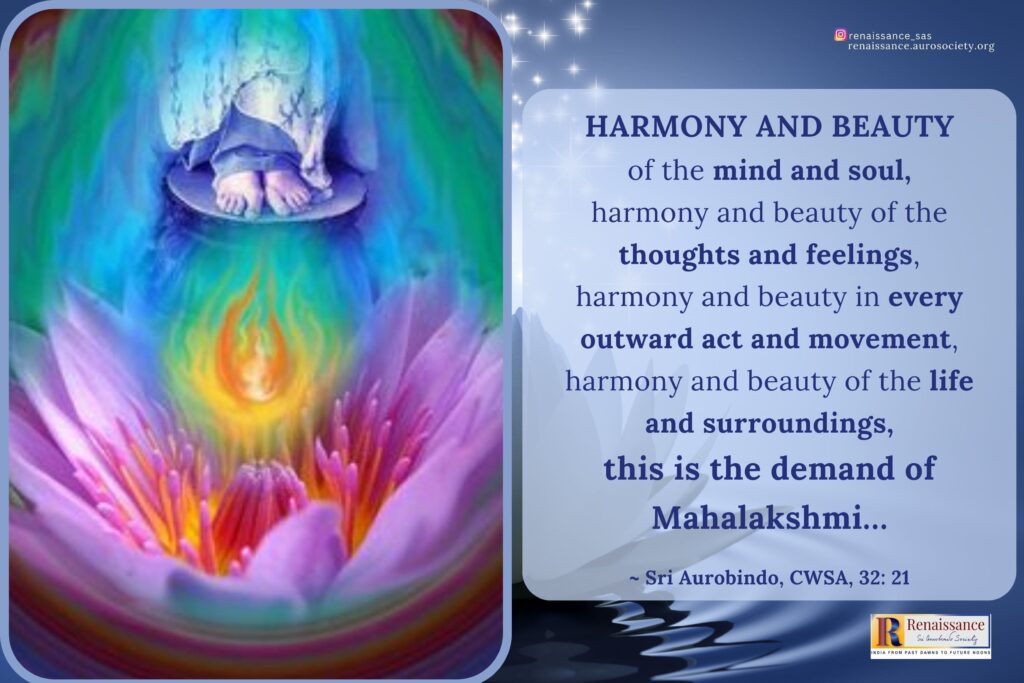“Indeed, men have always considered themselves victims harassed by adverse forces, those who are courageous fight, the others complain.”
(The Mother, CWM, Vol. 10, p. 118)
Courage or bravery refers to the act of doing something even though it is frightening or “out of our comfort zone”. Fear is the opposite of courage, yet sometimes when faced with fearful situations one discovers one’s hidden courage.
Courage is often a difficult trait to master. Throughout the world different forms of martial arts developed to help individuals strengthen themselves and face with greater confidence and courage challenging situations in life.

Courage and Sadhana
In our everyday life when confronting challenging situations and faced with obstacles, we need great courage. But when one takes to sadhana and sincere spiritual quest, courage becomes even more necessary. As the Mother frequently reminded the disciples and children at the Ashram, it takes a lot of courage to simply live according to the call of one’s real self.
To live a life of integrity, of simplicity, of being in a state of nirodha aka beingness, is the highest form of valour or courage. This kind of spiritual courage comes when one clearly knows what is right and what is wrong, when one can discern continuously, when at every step of life one takes actions without faltering and without giving up the path of integrity.
To follow the path of integrity, to follow the yama and niyama of yoga is not for the faint hearted. The kind of courage necessary must be resistant to being subdued by all kinds of fear. In other words, it is not the absence of fear rather its mastery which is essential.
The ‘Courage’ Flower
The Mother through her intuitive sight gave the spiritual significance of “courage” for the flower we know commonly as the Crown Flower, often used in religious rituals and offered particularly to Lord Shiva and Hanuman. The plant, Calotropis Gigantea, is a large shrub belonging to the milkweed family. The flowers are beautiful with five purple, pink or white petals and a small crown emerging in centre, hence the name crown flower.
It must be noted that the flower is poisonous and has to be handled with care. However, as the Charaka Samhita tells us, despite being poisonous, it has an innate ability to heal diabetes, stomach ulcers, digestive disorders, elephantiasis and various other ailments. It is indeed interesting that just as the crown flower has an ability to heal the core of our physical body, on a deeper level it holds within the vibration of inner courage which is also known to emerge from our core strength.
Also read:
Get Rid of Fear, Distrust and Despair
In the Indian knowledge systems, Dhanurveda or science of warfare is described as one of the eighteen branches of applied knowledge (also known as Upaveda). Learning and practice of traditional martial arts was always an important aspect of training the warriors. Rigorous physical training strengthens the person’s core and enhances the rajasic tattva in the Manipura chakra or solar plexus which in turn helps one become fearless and courageous.
“As soon as you enter the rajasic nature, you like effort. And at least the one advantage of rajasic people is that they are courageous, whereas the tamasic people are cowards. It is the fear of effort which makes one cowardly.”
(The Mother, CWM, Vol. 7, p. 26)

Arka and Lord Surya
Arka is the Sanskrit name given to Calotropis gigantea. Arka is also one of the names for Lord Surya as mentioned in Surya Ashtottra Shatanamavali. The Sun temple in Konark is known as Arka-tīrtha.
Being a very ancient plant, there are many references to Arka in old scriptural texts of Hindus. Once when the Gods were performing a sacrificial ritual for Lord Surya, the milk spilled. From the milk, sprang a plant which the Gods called as Arka. When we pick the flowers of this plant, a milky latex oozes out which again is poisonous and has to be handled with care.
Being the flower of Lord Surya, there are many ways in which this plant is used in rituals. On the day of Rathasaptami (the day when the sun’s chariot turns north) many devout Hindus take a purification bath using seven Arka leaves (one on their head, two on the shoulders, two on the knees and two on their soles). This ritual along with the chanting of the following stotra is said to give immense courage, valour, self-confidence and happiness. Also, the leaves are believed to help get rid of skin diseases.
Sapta Sapta Maha Sapta,
Sapta Dweepa Vasundara
Sapta Arka Parna Madaya,
Saptamyam Snana Maacharet
Arka Bhasma
Jyotisha, one of the six Vedanga-s which are the disciplines that supplement the study of Vedas, deals with calculation of time, observation of heavenly bodies and their movements. It concerns itself with astronomy and astrology — which is not about making predictions as is often narrowly believed — but rather a close study of forces caused by the movement of celestial bodies.
Jyotisha tells us that the sun is a luminary which rules our self-identity, vitality, joy, confidence and most importantly, imparts us courage. Interestingly, Arka bhasma or the sacred ash made from the roots of this plant is applied when the sun is said to be ill placed in a person’s natal chart. A person with a weak placement of sun is said to have low self-esteem and courage. Arka bhasma is said to ameliorate the condition and help the person become confident and courageous.
More on Arka Roots
Arka flowers are offered on the day of Ganapathi puja. It is said that the roots of Arka plant take the shape of Lord Ganesha as it grows older and hence it is very special to the Lord. The roots too have healing powers, and tribal women in some parts of India hold the Arka roots during the birth of a child. It not only eases the pain of childbirth but is also believed to keep them safe during child-birth.
Another ritual associated with Arka plant is called as Arka vivaha or the marriage ceremony with the roots of Arka. In the past, when a man lost his wives to death one after another, a ritual was performed where the man used to marry Arka plant. After this ceremony, the man was believed to be rid of the curse which was making him a widower.
Rediscovering Ancient Wisdom
Many rational minds in 21st century may find this to be a mere superstition, but we must recognise that there is indeed an amazing connection between nature and mankind which our ancestors revered and as a result were blessed with revelations of the hidden truths of nature – many of which modern science has also proved through its own methods.
In the course of time, a great bit of the wisdom hidden in Mother Nature’s gifts, once revealed by our ancient seers and sages, was forgotten. But thankfully there seems to be now a renewed interest in rediscovering these treasures, as we see today greater interest in holistic healing approaches such as Ayurveda and other traditional systems.
Courage and Faith
While courage can take many colours and forms in mundane life or in spiritual life, it has its firm foundation in faith. Faith is a state of unreserved openness to possibilities and profundities of life. Faith is to believe in the unknown, a signpost into the future.
Without a leap of faith, one cannot be courageous enough to build a relationship with one’s ishta deva, chosen deity or one’s Guru. Faith is indeed a pre-requisite for the immense courage needed in spiritual path.
“To walk through life armoured against all fear, peril and disaster, only two things are needed, two that go always together—the Grace of the Divine Mother and on your side an inner state made up of faith, sincerity and surrender.
(Sri Aurobindo, CWSA, Vol. 32, p. 9)

A Story from the Mahabharata
This faith when turned towards your teacher, is one-pointed focus which eventually takes us to the ultimate goal in our path. The power of faith when combined with courage is so clearly demonstrated in the story of Upamanyu in Mahabharata, Adi parva section. Upamanyu was the disciple of the great acharya Ayoda Dhaumya Muni who belonged to the lineage of Rig-Vedic rishis.
Once Upamanyu was instructed by his Guru to take the cows for grazing. When he returned to the ashram and offered his obeisance at the feet of his teacher, his teacher asked him what did Upamanyu eat all day as he wasn’t given food from the ashram. Upamanyu replied that he begged for alms. The Guru instructed him not to do so as he cannot have anything without the alms being offered to his teacher first.
Upamanyu obeyed and continued with his task of taking the cows for grazing. The days passed, and Upamanyu still seemed to be quite fit and healthy. The Guru again asked him what he had been sustaining upon. Upamanyu replied that he was offering to his guru the first alms that he received, but would then go again begging for second time to feed himself. The Guru instructed him that such a practice was not ethically acceptable as he was taking the food away from others in need, which Upamanyu again heartily obeyed.
You may also like:
Some Insights from Sri Aurobindo on the Guru-shishya Parampara
The story continues with Upamanyu still sustaining pretty well with no sign of weakness, and this time he tells the Guru that he has been living on the cow’s milk. The Acharya says that the cow’s milk is for the calves and not for him, and by taking the milk he is depriving the calves of their food. Upamanyu now stops drinking milk. But again, when seeing him healthy and fit the Guru asks him the source of his sustenance, he says that he lives on the froth that oozes out from the calves’ mouth after they sucked all the milk from the cow.
Again, the Acharya denies Upamanyu this privilege. Now, having nothing to eat, Upamanyu starts eating the flowers and leaves of Arka plant. Not knowing that these flowers are poisonous, he goes blind and falls into a well. When Upamanyu does not return to the Ashram, the Acharya gets concerned and goes searching for him. When he finds him intoxicated and blind, he tells him to pray to the twin Ashwinikumaras, the divine healers and ask for a cure.
Humbly and sincerely, Upamanyu offers his prayers with total faith, trust and courage. Ashwinikumaras are propitiated with Upamanyu’s prayers and come to offer him a cake to cure his blindness. But Upamanyu refuses that his Guru has ordered him not to eat anything offered to him without his permission. They try their best to make him eat, but to no avail. They are immensely pleased with Upamanyu’s steadfast guru-bhakti and not only grant him his health but also bless him with supreme auspiciousness.
Read more in the Flower Meditations HERE.
Stories such as these teach us the subtle meaning of faith, sincerity, trust in the unknown and the courage needed to stay on the path. For this, only one thing is needed and that is to be fearless.
“Fear is hidden consent. When you are afraid of something, it means that you admit its possibility and thus strengthen its hand. It can be said that it is a subconscient consent. Fear can be overcome in many ways. The ways of courage, faith, knowledge are some of them.”
(The Mother, CWM, Vol. 14, pp. 243-244)

Concluding Thoughts
Over the past few months, as I have meditated on the spiritual significance of flowers as intuitively guided by the Mother, I am beginning to not only understand the deeper meaning of these flowers but how they have been guiding humanity and mankind all along in their subtle but profound ways, healing us physically, mentally, emotionally, and of course spiritually.
We know that only by an inward turning and by quietening the noise of the mind and vital through concentration and meditation we can contact the truth of our true, inmost being. Similarly, to reveal the true essence and hidden powers of the flowers, we need to learn how to connect with their consciousness.
For this, we first need to spend some conscious time with them, grow them, see them blossom, talk to them and become friends with them. Only when we interact with nature in full inner awareness will we truly understand her secrets and powers.

~ Design: Biswajita Mohapatra and Beloo Mehra



